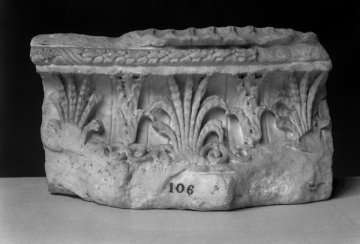Explore Collections


You are here:
CollectionsOnline
/
Fragment of the base of an antique column
Browse
Fragment of the base of an antique column
117-138 AD
Hadrianic
Hadrianic
Pentelic marble of statuary quality
Height: 18cm
Width: 31cm
Thickness: 10cm
Width: 31cm
Thickness: 10cm
Museum number: S106
On display: Study
All spaces are in No. 13 Lincoln's Inn Fields unless identified as in No. 12, Soane's first house.
For tours https://www.soane.org/your-visit
Curatorial note
In the present state, enrichment from top to bottom includes: fluted (half) cavetto, small carved torus, fillet (chipped), large cavetto enriched alternately with honeysuckle and stylised foliage, and a now ruined (but once elaborately enriched) lower moulding.
This fragment and Soane Museum nos. M582, M590 and S95 are similar and from the same or matching column bases.
Although there has as yet been no thorough study of bases on which sure comparisons can be based1, this set of fragments appears to present Hadrianic enrichment modelled generally from Augustan work in early first century AD, Rome; there are parallels for the working of the leaf details in the large cavetto in Asia Minor at this and somewhat earlier periods. The type is an adaptation of simpler type Greek anthemion enrichment, which was perhaps executed by Asiatic craftsmen working in Rome in the Augustan period, certainly by men schooled in this tradition of carving. A Hadrianic rather than Augustan dating is suggested by the similarity in the fluted cavetto and that of Soane M573 (Vermeule 79) from Hadrian's Villa at Tivoli, by the choice of stylised foliage between honeysuckle in the large cavetto, and primarily by the shadowed, high-relief carving of these last details.
These fragments of a free standing or engaged column base (or bases) may be linked with a perfectly preserved straight section of pilaster base which entered the Musei Capitolini, Rome (Palazzo della Conservtori) from the Roman art market (Barsanti) some time in the 1950s-70s. Not only do style and measurements point to similar origin, but the missing and worn enrichment of the Soane series may be restored from the Conservatori example (Room VII, no.9 at the time Vermeule wrote his cat. entry). Needless to say the mutilated condition of the series of Soane fragments does not permit full appreciation of the florid beauty of this most studied and elaborate carving.
1 The first study devoted to antique decorated bases in Rome was by M. Wegner, Schmuckbasen des antiken Rom, 1966. Since then there has been a recent study of Roman decorated bases by Charlotte Schreiter (1995): unfortunately the bases in the Soane collection were not considered, but comparison can be drawn e.g. fig 226, no. 25, p. 294 shows a very small fragment in the Chatsworth collection with a similar pattern of the cavetto, but very differently executed, and of an earlier date?
This fragment and Soane Museum nos. M582, M590 and S95 are similar and from the same or matching column bases.
Although there has as yet been no thorough study of bases on which sure comparisons can be based1, this set of fragments appears to present Hadrianic enrichment modelled generally from Augustan work in early first century AD, Rome; there are parallels for the working of the leaf details in the large cavetto in Asia Minor at this and somewhat earlier periods. The type is an adaptation of simpler type Greek anthemion enrichment, which was perhaps executed by Asiatic craftsmen working in Rome in the Augustan period, certainly by men schooled in this tradition of carving. A Hadrianic rather than Augustan dating is suggested by the similarity in the fluted cavetto and that of Soane M573 (Vermeule 79) from Hadrian's Villa at Tivoli, by the choice of stylised foliage between honeysuckle in the large cavetto, and primarily by the shadowed, high-relief carving of these last details.
These fragments of a free standing or engaged column base (or bases) may be linked with a perfectly preserved straight section of pilaster base which entered the Musei Capitolini, Rome (Palazzo della Conservtori) from the Roman art market (Barsanti) some time in the 1950s-70s. Not only do style and measurements point to similar origin, but the missing and worn enrichment of the Soane series may be restored from the Conservatori example (Room VII, no.9 at the time Vermeule wrote his cat. entry). Needless to say the mutilated condition of the series of Soane fragments does not permit full appreciation of the florid beauty of this most studied and elaborate carving.
1 The first study devoted to antique decorated bases in Rome was by M. Wegner, Schmuckbasen des antiken Rom, 1966. Since then there has been a recent study of Roman decorated bases by Charlotte Schreiter (1995): unfortunately the bases in the Soane collection were not considered, but comparison can be drawn e.g. fig 226, no. 25, p. 294 shows a very small fragment in the Chatsworth collection with a similar pattern of the cavetto, but very differently executed, and of an earlier date?
Rome; collected in Rome by Charles Heathcote Tatham for the architect Henry Holland during the 1790s. See Cornelius Vermeule, unpublished catalogue of the Antiquities at Sir John Soane's Museum, Introduction, transcription of Tatham letters, List 3, no. 30.
Literature
Tatham: Etchings, 17; Drawings, 8.
Soane collections online is being continually updated. If you wish to find out more or if you have any further information about this object please contact us: worksofart@soane.org.uk


